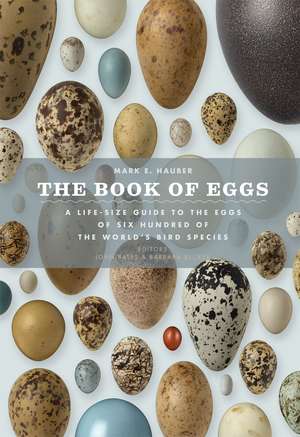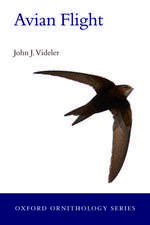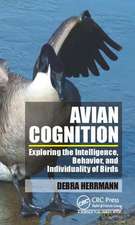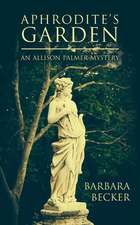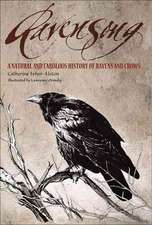The Book of Eggs: A Life-Size Guide to the Eggs of Six Hundred of the World's Bird Species
Autor Mark E. Hauber Editat de John Bates, Barbara Beckeren Limba Engleză Hardback – 28 mar 2014
From
the
brilliantly
green
and
glossy
eggs
of
the
Elegant
Crested
Tinamou—said
to
be
among
the
most
beautiful
in
the
world—to
the
small
brown
eggs
of
the
house
sparrow
that
makes
its
nest
in
a
lamppost
and
the
uniformly
brown
or
white
chickens’
eggs
found
by
the
dozen
in
any
corner
grocery,
birds’
eggs
have
inspired
countless
biologists,
ecologists,
and
ornithologists,
as
well
as
artists,
from
John
James
Audubon
to
the
contemporary
photographer
Rosamond
Purcell.
For
scientists,
these
vibrant
vessels
are
the
source
of
an
array
of
interesting
topics,
from
the
factors
responsible
for
egg
coloration
to
the
curious
practice
of
“brood
parasitism,”
in
which
the
eggs
of
cuckoos
mimic
those
of
other
bird
species
in
order
to
be
cunningly
concealed
among
the
clutches
of
unsuspecting
foster
parents.
The Book of Eggsintroduces readers to eggs from six hundred species—some endangered or extinct—from around the world and housed mostly at Chicago’s Field Museum of Natural History. Organized by habitat and taxonomy, the entries include newly commissioned photographs that reproduce each egg in full color and at actual size, as well as distribution maps and drawings and descriptions of the birds and their nests where the eggs are kept warm. Birds’ eggs are some of the most colorful and variable natural products in the wild, and each entry is also accompanied by a brief description that includes evolutionary explanations for the wide variety of colors and patterns, from camouflage designed to protect against predation, to thermoregulatory adaptations, to adjustments for the circumstances of a particular habitat or season. Throughout the book are fascinating facts to pique the curiosity of binocular-toting birdwatchers and budding amateurs alike. Female mallards, for instance, invest more energy to produce larger eggs when faced with the genetic windfall of an attractive mate. Some seabirds, like the cliff-dwelling guillemot, have adapted to produce long, pointed eggs, whose uneven weight distribution prevents them from rolling off rocky ledges into the sea.
A visually stunning and scientifically engaging guide to six hundred of the most intriguing eggs, from the pea-sized progeny of the smallest of hummingbirds to the eggs of the largest living bird, the ostrich, which can weigh up to five pounds,The Book of Eggsoffers readers a rare, up-close look at these remarkable forms of animal life.
The Book of Eggsintroduces readers to eggs from six hundred species—some endangered or extinct—from around the world and housed mostly at Chicago’s Field Museum of Natural History. Organized by habitat and taxonomy, the entries include newly commissioned photographs that reproduce each egg in full color and at actual size, as well as distribution maps and drawings and descriptions of the birds and their nests where the eggs are kept warm. Birds’ eggs are some of the most colorful and variable natural products in the wild, and each entry is also accompanied by a brief description that includes evolutionary explanations for the wide variety of colors and patterns, from camouflage designed to protect against predation, to thermoregulatory adaptations, to adjustments for the circumstances of a particular habitat or season. Throughout the book are fascinating facts to pique the curiosity of binocular-toting birdwatchers and budding amateurs alike. Female mallards, for instance, invest more energy to produce larger eggs when faced with the genetic windfall of an attractive mate. Some seabirds, like the cliff-dwelling guillemot, have adapted to produce long, pointed eggs, whose uneven weight distribution prevents them from rolling off rocky ledges into the sea.
A visually stunning and scientifically engaging guide to six hundred of the most intriguing eggs, from the pea-sized progeny of the smallest of hummingbirds to the eggs of the largest living bird, the ostrich, which can weigh up to five pounds,The Book of Eggsoffers readers a rare, up-close look at these remarkable forms of animal life.
Preț: 462.86 lei
Nou
Puncte Express: 694
Preț estimativ în valută:
88.57€ • 92.47$ • 73.30£
88.57€ • 92.47$ • 73.30£
Carte disponibilă
Livrare economică 15-29 martie
Preluare comenzi: 021 569.72.76
Specificații
ISBN-13: 9780226057781
ISBN-10: 022605778X
Pagini: 656
Ilustrații: 2400 color plates
Dimensiuni: 178 x 267 x 46 mm
Greutate: 2.18 kg
Editura: University of Chicago Press
Colecția University of Chicago Press
ISBN-10: 022605778X
Pagini: 656
Ilustrații: 2400 color plates
Dimensiuni: 178 x 267 x 46 mm
Greutate: 2.18 kg
Editura: University of Chicago Press
Colecția University of Chicago Press
Notă biografică
Mark E. Hauber is professor in the Animal Behavior and Conservation Program at Hunter College, City University of New York.
Recenzii
“Hauber
has
collected
images
of
the
eggs
of
six
hundred
of
the
world’s
bird
species
and
presents
them
in
life
size
and
full
color
with
supporting
illustrations
and
text
in
a
manner
that
is
both
fascinating
as
well
as
informative.
.
.
.
The
wonders
of
the
amazing
variety
of
shapes,
sizes,
colors,
peculiarities,
evolutionary
adaptations,
and
all
the
other
elements
that
for
so
long
held
so
many
naturalists
in
thrall
to
bird
eggs
will
begin
to
make
their
charms
understood—without,
of
course,
any
risk
to
the
bird
populations
themselves.”
"A fabulous reference book, every image in lovely color—one image of the egg actual size and one of the egg larger, for detail—with sketches of the birds and maps showing territory. It’s fascinating to leaf through, and affirming: On every page, it’s spring!"
“Oology gets a boost this week. . . . The Book of Eggs is a beautiful doorstopper of a guide to the eggs of six hundred bird species.”
“Stunning. . . . Sometimes we are oblivious to miraculous objects in our daily lives. [The Book of Eggs] prompts us to see eggs in a new light.”
“Who cares whether the chicken or the egg came first? The egg is far more interesting—at least in author Mark Hauber’s hands. . . . Hauber drew on the Field Museum’s collection of 23,000 sets of bird eggs to write The Book of Eggs, an illustrated field guide that explores the avian birthing process. . . . Eggs produced by the gray-hooded Sierra-finch, yellow-billed loon, and glossy ibis are among the treasures featured.”
“Boiled, coddled, fried, scrambled, or poached, our usual interaction with eggs is as a consumer: the inside is to be eaten. Once broken, the shell is lobbed in the bin and forgotten. Except that this is probably not what you are going to do after reading The Book of Eggs. Newly enlightened on egg biology and physiology, you may find yourself pointing out that the dimple in the broad end of an egg is where the air sac lay. Or perhaps you will be motivated to look at an egg shell through a lens, the better to see the tiny pores that allow air in while keeping water and toxins out—or even pause before eating your fried egg to dissect the yolk in search of its seven layers.”
“A welcome reference in an ornithology lab and a good reference for other audiences interested in bird eggs.”
“Unlike most mammals, birds lay eggs, a curious and wildly successful reproductive strategy that has fascinated humans for millennia. Chicago’s Field Museum of Natural History maintains one of the world’s largest collections of bird eggs, and this new guidebook offers a detailed (and life-sized) look at six hundred of them, from the eggs of the common house sparrow to the elegant crested tinamou.”
“A lovely addition to a bird enthusiast’s bookshelf or any actively browsed coffee table.”
Descriere
From the brilliantly green and glossy eggs of the Elegant Crested Tinamou—said to be among the most beautiful in the world—to the small brown eggs of the house sparrow that makes its nest in a lamppost and the uniformly brown or white chickens’ eggs found by the dozen in any corner grocery, birds’ eggs have inspired countless biologists, ecologists, and ornithologists, as well as artists, from John James Audubon to the contemporary photographer Rosamond Purcell. For scientists, these vibrant vessels are the source of an array of interesting topics, from the factors responsible for egg coloration to the curious practice of “brood parasitism,” in which the eggs of cuckoos mimic those of other bird species in order to be cunningly concealed among the clutches of unsuspecting foster parents.
The Book of Eggs introduces readers to eggs from six hundred species—some endangered or extinct—from around the world and housed mostly at Chicago’s Field Museum of Natural History. Organized by habitat and taxonomy, the entries include newly commissioned photographs that reproduce each egg in full color and at actual size, as well as distribution maps and drawings and descriptions of the birds and their nests where the eggs are kept warm. Birds’ eggs are some of the most colorful and variable natural products in the wild, and each entry is also accompanied by a brief description that includes evolutionary explanations for the wide variety of colors and patterns, from camouflage designed to protect against predation, to thermoregulatory adaptations, to adjustments for the circumstances of a particular habitat or season. Throughout the book are fascinating facts to pique the curiosity of binocular-toting birdwatchers and budding amateurs alike. Female mallards, for instance, invest more energy to produce larger eggs when faced with the genetic windfall of an attractive mate. Some seabirds, like the cliff-dwelling guillemot, have adapted to produce long, pointed eggs, whose uneven weight distribution prevents them from rolling off rocky ledges into the sea.
A visually stunning and scientifically engaging guide to six hundred of the most intriguing eggs, from the pea-sized progeny of the smallest of hummingbirds to the eggs of the largest living bird, the ostrich, which can weigh up to five pounds, The Book of Eggs offers readers a rare, up-close look at these remarkable forms of animal life.
The Book of Eggs introduces readers to eggs from six hundred species—some endangered or extinct—from around the world and housed mostly at Chicago’s Field Museum of Natural History. Organized by habitat and taxonomy, the entries include newly commissioned photographs that reproduce each egg in full color and at actual size, as well as distribution maps and drawings and descriptions of the birds and their nests where the eggs are kept warm. Birds’ eggs are some of the most colorful and variable natural products in the wild, and each entry is also accompanied by a brief description that includes evolutionary explanations for the wide variety of colors and patterns, from camouflage designed to protect against predation, to thermoregulatory adaptations, to adjustments for the circumstances of a particular habitat or season. Throughout the book are fascinating facts to pique the curiosity of binocular-toting birdwatchers and budding amateurs alike. Female mallards, for instance, invest more energy to produce larger eggs when faced with the genetic windfall of an attractive mate. Some seabirds, like the cliff-dwelling guillemot, have adapted to produce long, pointed eggs, whose uneven weight distribution prevents them from rolling off rocky ledges into the sea.
A visually stunning and scientifically engaging guide to six hundred of the most intriguing eggs, from the pea-sized progeny of the smallest of hummingbirds to the eggs of the largest living bird, the ostrich, which can weigh up to five pounds, The Book of Eggs offers readers a rare, up-close look at these remarkable forms of animal life.
